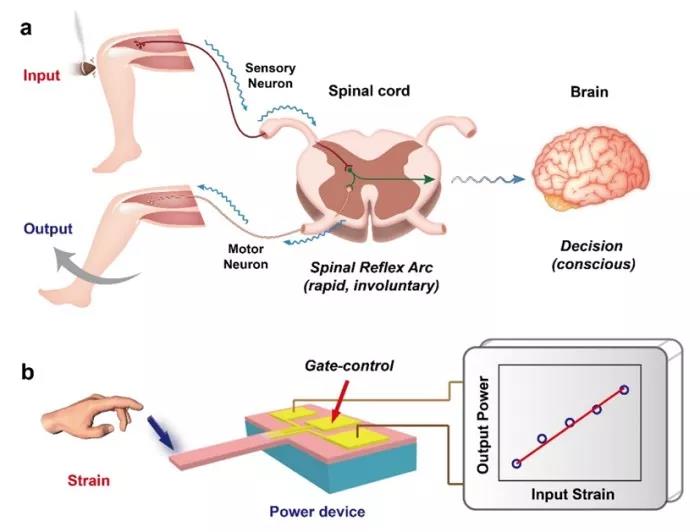
hotline:
17715390137
Tel/Wechat:
18101240246 (Technology)
0512-68565571
Email:mxenes@163.com (Sales Engineer)bkxc.bonnie@gmail.com
Scan the code to follow or search the official account on WeChat:
2D Materials Fronrier After paying attention,
click on the lower right corner to contact us,
Enter enterprise WeChat.
Professional Services Online

 【introduction】
【introduction】
Intelligent power devices are widely used in basic power control to advanced power topology networks. The traditional power system that responds to external mechanical signals usually consists of a series of stress sensors, A / D or D / A converters, strong / weak current isolators, power devices, etc., and realizes long-chain control of feedback under CPU control. system. Intelligent power devices that directly respond to external mechanical signals are helpful to simplify system complexity, improve reliability and response speed, and have potential application value in areas such as automatic control and artificial intelligence.
[Achievement Profile]
The human conditioned-non-conditioned reflex system is a successful example of real-time, sensitive response / feedback of external mechanical signals, such as the knee jump movement of the leg in response to mechanical stimulation in real time under the control of the spinal reflex arc, while still being monitored by the high nerve center. Drawing on this composite control system, the research team of Academician Wang Zhonglin and Researcher Hu Weiguo of the Institute of Nano Energy and Systems of the Chinese Academy of Sciences designed a new type of intelligent stress regulating power device (SPD) based on piezoelectric electronics, which can realize weak mechanical signals to high power The direct, real-time, and programmable control of density power builds a conditional-unconditional hierarchical control system. AlGaN / GaN HEMT (High Electron Mobility Transistor) is a new generation of high-temperature, high-voltage, high-power power electronic devices that have attracted much attention. It is widely used in energy, industrial power, automotive electronics, and automatic control. In the research, the same-anisotropic dry etching technique was used to prepare AlGaN / GaN HEMT units on the cantilever structure at the micrometer scale. Based on the theory of piezoelectric electronics proposed by Academician Wang Zhonglin in 2006, weak external mechanical signals modulate AlGaN / The intensity and distribution of the piezoelectric polarization field at the GaN heterojunction, thereby modulating the two-dimensional electron gas concentration, and finally realizing the direct control of high-power power output; meanwhile, the electrical grid is retained to control the responsiveness of power to the mechanical signal response. Programmable control similar to the high nerve center. Using this new type of intelligent stress-regulating power device, a new hierarchical control system for acceleration feedback power control is verified. This new type of intelligent power device can greatly simplify the complexity of the system, greatly reduce the cost of the system, and at the same time improve the reliability and response speed. It is conducive to the construction of multi-channel parallel and distributed networks, and further reduces the impact of partial unit failure on the stability of the system. , Will have a wide range of applications in the areas of autonomous driving, bionic robots, and automatic control.
The research results were titled "Strain-controlled power devices as inspired by human reflex" and published in the recent "Nature Communications". Co-corresponding authors are Associate Research Fellow of Hua Qilin, Researcher Hu Weiguo, and Academician Wang Zhonglin, Beijing Institute of Nano Energy and Systems, Chinese Academy of Sciences. This research work has been funded by the National Natural Science Foundation of China, the National Key Research and Development Program, and the Chinese Academy of Sciences Hundred Talents Program.
Figure 1 New intelligent stress-regulated power devices inspired by human nerve reflexes

a schematic diagram of the human knee jump reflection process;
b. Conceptual diagram of a new type of intelligent stress control power device (SPD).
Figure 2 Structure and characterization of SPD

a schematic diagram of a micron-scale cantilever structure AlGaN / GaN HEMT unit;
b. Scanning electron microscopy (SEM) photo of the device unit;
c. Elemental distribution map of AlGaN / AlN / GaN heterojunction;
d. High resolution transmission electron microscopy (TEM) pictures of AlGaN / AlN / GaN heterojunctions.
Figure 3 Electrical characteristics of SPD

a, b. SPD output characteristic and transfer characteristic curve;
c. Comparison of Raman spectrum of AlGaN / AlN / GaN heterojunction with or without micrometer cantilever structure;
d, e. Output characteristics of SPD under different stresses (0-16 mN) when the gate voltage is -5 V and 1 V, respectively;
f. Transconductance characteristic curves of SPD under different stresses (0mN, 4 mN and 16 mN).
Figure 4 SPD stress

a. When the grid voltage is -5 V and 1 V, the output power density of the SPD under different stresses (0-16 mN);
b. The relationship between the output power density of SPD and the input strain and grid voltage;
c. The relative output power density of the SPD during cyclic loading / releasing stress.
Figure 5 Repeatable stress dependence analysis of the device

a. SPD output characteristic curve during continuous loading / releasing stress (0/16 mN);
b. The relationship between SPD output and different stresses (0-16 mN) when the gate voltage is -10 V and 0 V.
Figure 6 SPD acceleration feedback power control

a. Conceptual diagram of automatic unsupervised output power adjustment of an autonomous vehicle under emergency braking conditions;
b. Conceptual diagram of power self-adjustment for the robot to achieve attitude balance during the movement process;
c. Real-time self-adjusting output power of SPD under different acceleration (1-5G);
d. The relationship between the SPD output power density change and acceleration.
Article link:
https://www.nature.com/articles/s41467-019-14234-7
Source-WeChat public: material source

| Reminder: Beijing Beike New Material Technology Co., Ltd. supplies products only for scientific research, not for humans |
| All rights reserved © 2019 beijing beike new material Technology Co., Ltd 京ICP备16054715-2号 |